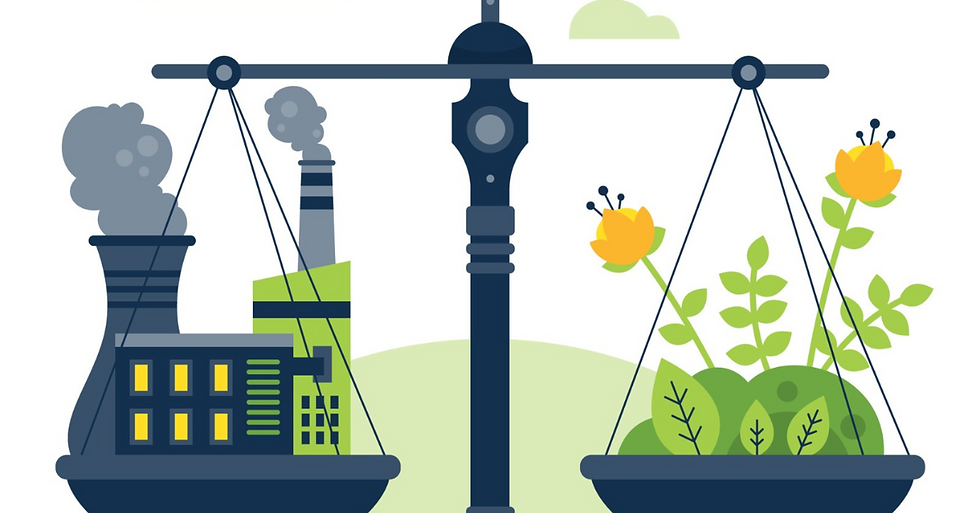Do you know whats involved in Decarbonising your supply chain?
- Chris Gunn

- Feb 11
- 3 min read
Updated: Mar 21

Decarbonizing your supply chain involves a comprehensive approach to reduce carbon emissions across the entire value chain. It’s a key part of making your business more sustainable, and it can involve multiple steps depending on your industry and supply chain complexity. Here are some strategies to help you get started:
1. Measure and Analyze Emissions
Map your supply chain: Identify the key suppliers, products, and processes contributing to emissions.
Emissions Inventory: Calculate the emissions across Scope 1, 2, and 3.
Scope 1: Direct emissions from owned or controlled sources.
Scope 2: Indirect emissions from the generation of purchased energy.
Scope 3: All other indirect emissions, including those from supply chain partners.
Use tools like the Greenhouse Gas (GHG) Protocol or other carbon accounting software to track emissions.
2. Engage Suppliers
Set clear expectations: Work with suppliers to help them understand your sustainability goals. Encourage them to adopt similar measures, like reducing energy use, improving transportation efficiency, or using low-carbon materials.
Collaborative efforts: Develop joint sustainability programs with suppliers to reduce carbon footprints together.
Supplier sustainability audits: Evaluate your suppliers based on their environmental practices and emissions reductions, and prioritize those that align with your sustainability goals.
3. Reduce Energy Use
Energy-efficient production: Help your suppliers implement energy-efficient practices in manufacturing or processing.
Renewable energy: Encourage or incentivize the shift to renewable energy sources like solar or wind.
Energy audits: Assess energy usage across different parts of the supply chain and identify areas for improvement.
4. Sustainable Transportation
Optimize logistics: Reduce the number of shipments, optimize delivery routes, and consolidate shipments to lower transportation emissions.
Low-carbon transport options: Shift towards electric vehicles (EVs), hydrogen-powered trucks, or even rail transport instead of road transport.
Eco-friendly packaging: Work with suppliers to reduce packaging material and use more sustainable alternatives.
5. Procure Sustainable Materials
Sustainable sourcing: Choose materials with lower carbon footprints, such as recycled or sustainably sourced raw materials.
Circular economy: Design for product life-cycle sustainability, including taking materials back for reuse or recycling at the end of a product's life.
Supplier transparency: Work with suppliers who have transparent sustainability and emissions data.
6. Incorporate Carbon Pricing
Internal carbon pricing: Set an internal carbon price to reflect the environmental cost of emissions, which can guide decision-making and incentivize low-carbon solutions.
Carbon credits and offsets: Consider using carbon credits or other offset mechanisms to balance out emissions that are difficult to eliminate directly.
7. Digital Tools and Technology
Supply chain management software: Use technologies such as AI, blockchain, or IoT to enhance visibility into your supply chain, allowing for more efficient, transparent, and low-carbon operations.
Predictive analytics: Leverage predictive models to optimize inventory and demand management, reducing excess production and waste.
8. Invest in Innovation and Green Technologies
Research and development: Invest in the development of new, more sustainable materials, products, and processes.
Green technologies: Adopt innovations such as carbon capture technologies or use of alternative, greener fuels in transportation.
9. Collaborate with Industry Groups and Standards
Industry standards: Engage with initiatives such as the Science Based Targets initiative (SBTi), which helps businesses set net-zero targets that align with the latest climate science.
Collaborative action: Join industry groups focused on decarbonizing supply chains, as they may provide resources and best practices that you can implement.
10. Create a Decarbonization Roadmap
Set goals and milestones: Break down the carbon reduction targets into specific, measurable goals for different parts of the supply chain.
Communication: Regularly update stakeholders on your decarbonization progress, including suppliers, customers, and investors.
Continuous improvement: Decarbonization is an ongoing process. Regularly review and revise your strategy to ensure you’re making progress and addressing new challenges.
11. Advocate for Policy Change
Policy engagement: Support policies that promote low-carbon technologies, carbon pricing, and other green initiatives.
Collective action: Work with other companies and organizations to encourage governments to create frameworks that help reduce supply chain emissions at scale.
By following these steps, you can significantly reduce your supply chain's carbon footprint, making a positive impact on both the environment and your bottom line. Sustainability has become a competitive advantage, and many customers and investors are placing increasing importance on it. So, getting ahead in decarbonization can benefit your reputation and profitability as well.
Ready to get started? Contact me to book an appointment



Comments